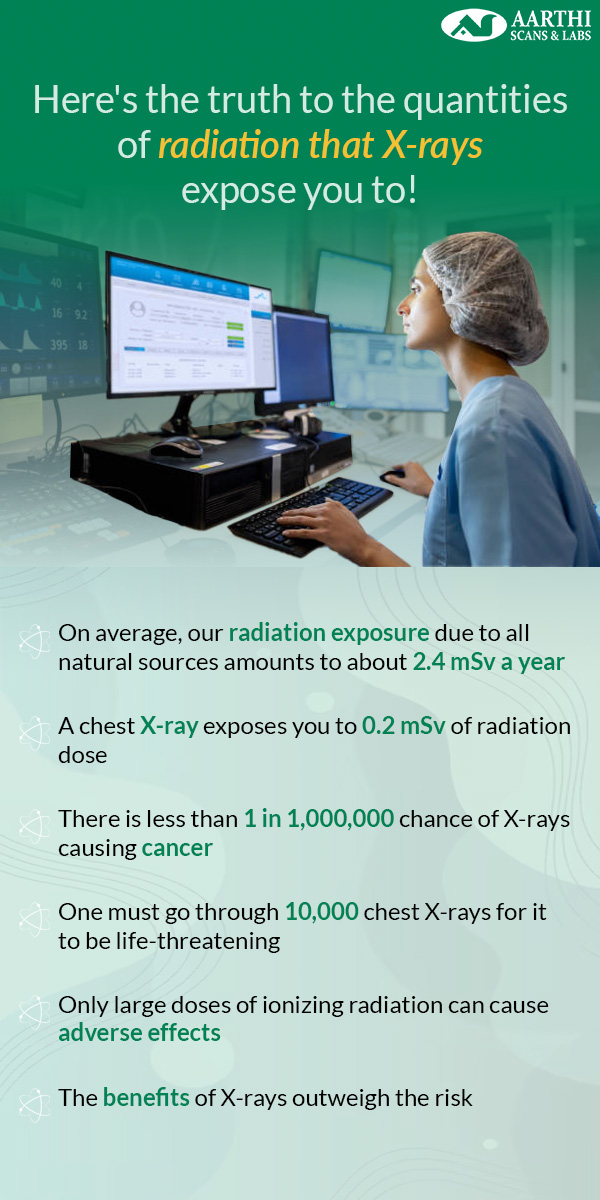Are you concerned about the potential risks and damage that radiation from X-rays can cause? Are you looking for answers for the question are X-rays unsafe? Get to know the factual truth about the widely used diagnostic tool!
What are X-rays?
X-rays produce images of bones and internal organs to reveal signs of diseases and injury. Discovered 100 years ago, the X-ray has played a pivotal role in saving countless lives and has been instrumental in significant discoveries.
X-rays in different diagnostic procedures
- Radiography – The most popularly used method to produce images of bones. The radiation used is very low.
- Fluoroscopy – Used to observe the motion within the body and certain diagnostic and treatment procedures involving the gut and, it uses slightly higher amounts of radiation than a standard X-ray.
- Computed Tomography (CT) – produces more detailed still images and hence uses the highest dose of X-rays.
How safe are X-rays?
While X-rays use ionizing radiation, which can cause damage to the DNA, the doses used in the procedure are generally too low to cause any immediate or long-lasting adverse side effects. However, it is recommended to use as few doses as possible. In certain cases, field of radiation oncology uses high doses of radiation to halt the proliferation of cancer cells.
The radiation dose from a simple X-ray examination such as a chest X-ray is very low and smaller than what we naturally get exposed to from the environment.
CT and certain interventional procedures such as angiography and cardiac catheterization use higher doses of radiation, about 100 to 1000 times more than a chest X-ray. One must go through 25 chest CT scans or 10,000 chest X-rays for it to be life-threatening. There is less than a 1 in 1,000,000 chance of causing cancer.
Possible side effects of radiation
The carcinogens in X-rays can cause mutations in DNA and therefore cause cancer. Radiation can also cause tissue damage like cataracts, redness of the skin, hair loss, etc.
The contrast material, which improves the visibility of X-ray-based imaging techniques, causes temporary side effects such as itching, skin rashes and mild hypersensitive reactions.
However, the amount of radiation used in radiation can rarely cause any immediate impact or long-lasting damage.
There have been no reported cases linking radiation exposure from diagnostic and interventional procedures to infertility or cataracts. There is no practical evidence of side effects from any research.
What do you need to know?
X-rays can be performed by any medical technician. X-rays need to be performed only after communicating the risks and benefits with the patients clearly.
Safety measures are essential when it comes to X-rays. Proper maintenance of the equipment and dose management are essential to minimize the risk.
Alternatives to X-ray
Though X-rays are the most common and easiest diagnostic tool prevalent, there are alternative diagnostic procedures like Ultrasound and MRI which do not use X-rays or radioactivity. In medical examinations, ultrasound examines the pelvis and abdomen, especially during pregnancy, and assesses the breast, testes, and soft tissues of the neck and limbs. MRI is progressively becoming more prevalent for scanning the head, spine, and joints.
X-rays, which have transformed medical science, play a crucial role in providing accurate diagnoses and guiding treatment decisions. Although there are potential risks, the benefits, including diagnostic accuracy, non-invasiveness, quick results, procedural guidance, and cost-effectiveness, outweigh these risks when used responsibly and following established safety protocols. Aarthi Scans and Labs prioritizes the safety of patients above all and ensures transparency in all of their procedures.


